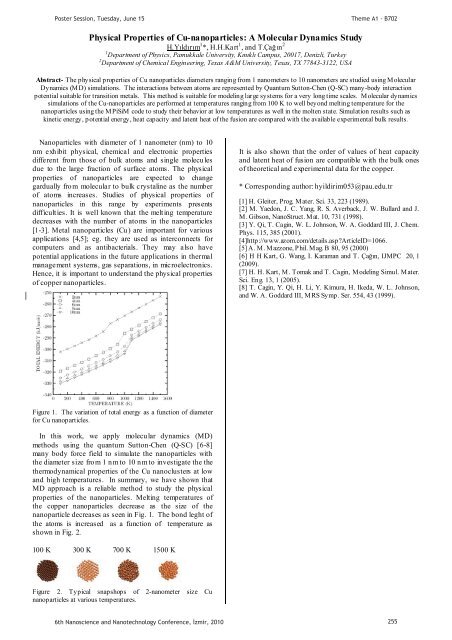Photonic crystals in biology
Photonic crystals in biology
Photonic crystals in biology
Create successful ePaper yourself
Turn your PDF publications into a flip-book with our unique Google optimized e-Paper software.
Poster Session, Tuesday, June 15<br />
Theme A1 - B702<br />
Physical Properties of Cu-nanoparticles: A Molecular Dynamics Study<br />
H.Y 1 *, H.H.Kart 1 ,andT.Ç 2<br />
1 <br />
2<br />
Department of Chemical Eng<strong>in</strong>eer<strong>in</strong>g, Texas A&M University, Texas, TX 77843-3122, USA<br />
Abstract- The physical properties of Cu nanoparticles diameters rang<strong>in</strong>g from 1 nanometers to 10 nanometers are studied us<strong>in</strong>g Molecular<br />
Dynamics (MD) simulations. The <strong>in</strong>teractions between atoms are represented by Quantum Sutton-Chen (Q-SC) many-body <strong>in</strong>teraction<br />
potential suitable for transition metals. This method is suitable for model<strong>in</strong>g large systems for a very long time scales. Molecular dynamics<br />
simulations of the Cu-nanoparticles are performed at temperatures rang<strong>in</strong>g from 100 K to well beyond melt<strong>in</strong>g temperature for the<br />
nanoparticles us<strong>in</strong>g the MPiSiM code to study their behavior at low temperatures as well <strong>in</strong> the molten state. Simulation results such as<br />
k<strong>in</strong>etic energy, potential energy, heat capacity and latent heat of the fusion are compared with the available experimental bulk results.<br />
Nanoparticles with diameter of 1 nanometer (nm) to 10<br />
nm exhibit physical, chemical and electronic properties<br />
different from those of bulk atoms and s<strong>in</strong>gle molecules<br />
due to the large fraction of surface atoms. The physical<br />
properties of nanoparticles are expected to change<br />
gardually from molecular to bulk crystal<strong>in</strong>e as the number<br />
of atoms <strong>in</strong>creases. Studies of physical properties of<br />
nanoparticles <strong>in</strong> this range by experiments presents<br />
difficulties. It is well known that the melt<strong>in</strong>g temperature<br />
decreases with the number of atoms <strong>in</strong> the nanoparticles<br />
[1-3]. Metal nanoparticles (Cu) are important for various<br />
applications [4,5]; eg. they are used as <strong>in</strong>terconnects for<br />
computers and as antibacterials. They may also have<br />
potential applications <strong>in</strong> the future applications <strong>in</strong> thermal<br />
management systems, gas separations, <strong>in</strong> microelectronics.<br />
Hence, it is important to understand the physical properties<br />
of copper nanoparticles.<br />
It is also shown that the order of values of heat capacity<br />
and latent heat of fusion are compatible with the bulk ones<br />
of theoretical and experimental data for the copper.<br />
* Correspond<strong>in</strong>g author: hyildirim053@pau.edu.tr<br />
[1] H. Gleiter, Prog. Mater. Sci. 33, 223 (1989).<br />
[2] M. Yaedon, J. C. Yang, R. S. Averback, J. W. Bullard and J.<br />
M. Gibson, NanoStruct. Mat. 10, 731 (1998).<br />
[3] Y. Qi, T. Cag<strong>in</strong>, W. L. Johnson, W. A. Goddard III, J. Chem.<br />
Phys. 115, 385 (2001).<br />
[4]http://www.azom.com/details.aspArticleID=1066.<br />
[5] A. M. Mazzone, Phil. Mag. B 80, 95 (2000)<br />
[6<br />
(2009).<br />
[7] H. H. Kart, M. Tomak and T. Cag<strong>in</strong>, Model<strong>in</strong>g Simul. Mater.<br />
Sci. Eng. 13, 1 (2005).<br />
[8] T. Cag<strong>in</strong>, Y. Qi, H. Li, Y. Kimura, H. Ikeda, W. L. Johnson,<br />
and W. A. Goddard III, MRS Symp. Ser. 554, 43 (1999).<br />
Figure 1. The variation of total energy as a function of diameter<br />
for Cu nanoparticles.<br />
In this work, we apply molecular dynamics (MD)<br />
methods us<strong>in</strong>g the quantum Sutton-Chen (Q-SC) [6-8]<br />
many body force field to simulate the nanoparticles with<br />
the diameter size from 1 nm to 10 nm to <strong>in</strong>vestigate the the<br />
thermodynamical properties of the Cu nanoclusters at low<br />
and high temperatures. In summary, we have shown that<br />
MD approach is a reliable method to study the physical<br />
properties of the nanoparticles. Melt<strong>in</strong>g temperatures of<br />
the copper nanoparticles decrease as the size of the<br />
nanoparticle decreases as seen <strong>in</strong> Fig. 1. The bond leght of<br />
the atoms is <strong>in</strong>creased as a function of temperature as<br />
shown <strong>in</strong> Fig. 2.<br />
100 K 300 K 700 K 1500 K<br />
Figure 2. Typical snapshops of 2-nanometer size Cu<br />
nanoparticles at various temperatures.<br />
6th Nanoscience and Nanotechnology Conference, zmir, 2010 255













